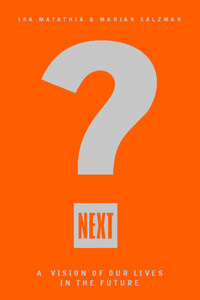Next:
A Vision of Our Lives in the Future
Ira Matathia, Marian Salzman
Ann O’Reilly, Christy Lane Plummer
People tend not to think about the future. In fact, I would wager that most of us have a pretty limited sense of what we’re likely to be doing any time after next Wednesday. The authors, on the other hand, do very little other than think about the future – in fact, they virtually live there.
But, unlike so many ‘futurists’, this team of authors has a genuine capacity to generate knowledge about trends and social movements that business people can actually use. And, today, that’s one of the most valuable skills around. After all, nowadays just keeping up with life is a defensive proposition.
Technology and information are moving at a breathtaking pace. We’ve created enough gadgets to keep us busy pretty much every waking hour. And that’s getting to be all twenty-four, since we can go online all night long – to check a stock market halfway around the world or buy anything from a paperback to a three-bedroom apartment.
As consumers and corporations alike teeter on the brink of overload, who has time to think ahead? Or to try to understand the impact all this change will have on our world, our attitudes, everything? The present is overwhelming enough.
Of course, there’s a huge opportunity in all this uncertainty. Marketers have always needed to understand consumers’ current concerns and experiences with their brands. But if they are to thrive in the years ahead, they must also anticipate where technology, social trends and a myriad of other change agents are leading, so that their new products and services will have a place in the consumer future.
Ed Vick
Chief Operating Officer, Young & Rubicam Inc.
We’re living in a fascinating age, for even those people who claim to be immune to millennium fever can’t help but wonder what lies on the other side of the date we’ve long held to represent the future. In these last days of the twentieth century, we’re focused not so much on the triumphs of the last hundred years as on the promise and uncertainty of the next hundred. If this century saw the global adoption of automobiles and electric lights, men walking on the moon and advances in medicine that have extended average life expectancies into one’s seventies or eighties, what might the next century bring? How will those of us who will be alive in 2050 be living? What will our homes be like? How will we get from one place to another? How will we shop – and what will we be shopping for?
While literature abounds with long-term prognostications about life next, our view is more pragmatic. Here’s why. International. Global. Worldwide. We’re living in what we used to call ‘the future’. In 1955 Canadian academic Marshall McLuhan on Take Thirty (CBC Television) explained, ‘There are no remote places. Under instant circuitry, nothing is remote in time or in place. It’s now.’ McLuhan is credited with being the first person who genuinely understood that technology was changing and would change mass media, and that mass media and contemporary life are so interconnected that everything would change, fast and hard. Those of us who spent part of the seventies contemplating his work recognize that we are already living in his ‘global village’ and understand how essential it is to decode our present, rather than live life with an eye on the rearview mirror. In the nineties, the present is an enormously important tool for those in the trendtracking business, and especially for those in global marketing communications.
Why do advertising people care about trends? On a simplistic level, the success of an ad campaign is predicated on whether the marketing message is on trend. It’s often said that advertising is a window on culture. We think that’s true, and that’s why anything that can be used to monitor change and change agents is a fundamental tool for effective marketing communications. So, in our work as advertisers, we appreciate the degree to which accurate trendtracking is critical to the marketing process. Accurately spotting and forecasting trends is of fundamental importance in determining whether an ad is a genuine asset to a brand (ideally by becoming a part of popular culture) or simply a negligible wave over which channel surfers pass.
Think of trends as human: they have a life cycle. That is, they are sown or fertilized, they gestate, they grow, mature, age and eventually die. Some trends are reincarnated a decade or more later, often in slightly different form.








